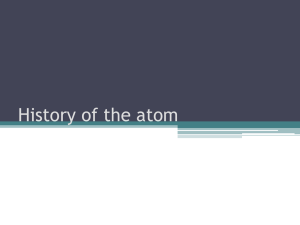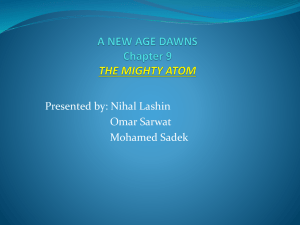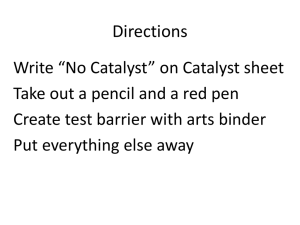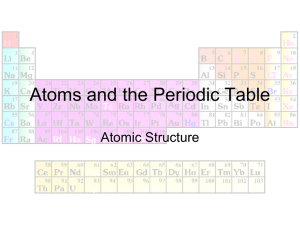History of Atomic Theory
advertisement
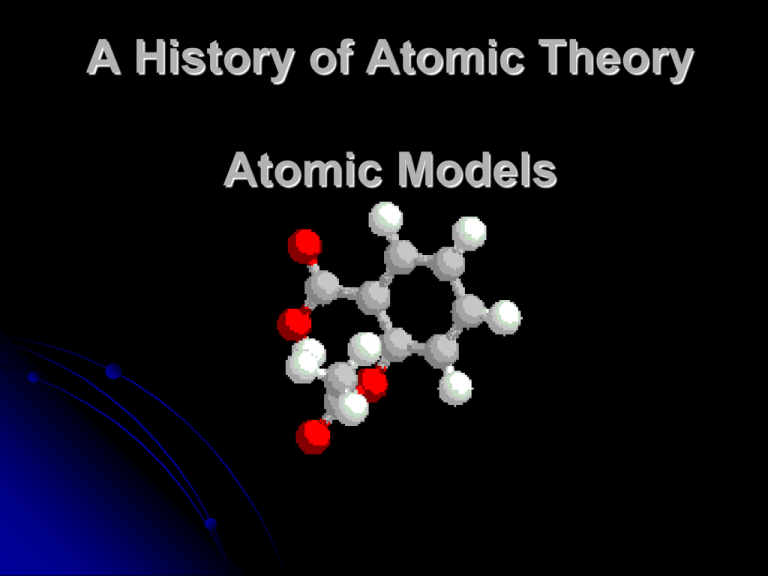
A History of Atomic Theory Atomic Models What is a model ? MODEL: detailed, 3-D representation of an object, (typically on smaller scale than original) model airplane model car clothing model Let’s Take a Trip Through Time! It Started with the Greeks DEMOCRITUS • Lived in Greece 2500 years ago (460-370 BC) • “Father of modern science” Demacritus said: “All matter is made of atoms that are tiny, indestructible and indivisible.” Democritus Greek banknote with Democritus and drawing of atom Where did Democritus get his ideas for small, indestructible, indivisible atoms? Atoms are small… new rings old ring EVIDENCE: Old gold rings wear away slowly, getting thinner and thinner, but you never see gold atoms on your finger, so gold atoms must be very small! Atoms are indestructible… EVIDENCE: • Earth has been around long time • Mountains wash away but rocks continue to exist • New plants grow where old plants die Atoms are indivisible… EVIDENCE: None This was HYPOTHESIS made by Democritus to explain nature as he saw it. What did Democritus think atoms looked like? Appearance of atoms assumed based on behavior: • Liquids pour • Solids are hard and rigid Liquids pour. Why? Liquids require a container If liquid atoms were like little balls they would roll out when you tip the container Greek idea of liquid atom Solids are rigid. Why? cocklebur plant Velcro® fastener cockleburs stick on clothing and each other Velcro hooks and loops little hooks on cockleburs Greek idea of solid atom Aristotle had other ideas Greek banknote and coin picturing Aristotle ARISTOTLE: Famous Greek philosopher, born 384 BC. • student of Plato (another famous philosopher) • teacher of Alexander the Great (who later conquered the world) Aristotle’s idea of matter Aristotle did not believe Democritus’s idea of atoms was correct Aristotle believed all matter made from four elements: Earth Air Fire Water Aristotle’s idea of matter Aristotle was more famous than Democritus, so people believed him, even though he was wrong! Democritus’s idea of atomos (atoms) was lost for nearly 2000 years until John Dalton brought it back in 1803 Atom idea lost for ~2000 years John Dalton, New Atom,1803 Born in England, 1766 Studied chemistry, physics, and color blindness Brought back Democritus’s idea of an indivisible atom Color blindness Can you see a number in this box? If not, you may be color blind. (More males are color blind than females) Start writing - Foldable information Dalton’s Theory of Atoms Five parts (postulates): # 1: Elements are made of extremely small particles called atoms # 2: Atoms of given element are identical in size, mass, & other properties; Atoms of different elements are different in size, mass, & other properties (later found not to be exactly correct) #3: Atoms cannot be subdivided, created, or destroyed (later proved wrong) So according to Dalton’s theory: atoms are considered to be like billiard balls #4: Atoms of different elements combine in simple whole-number ratios to form chemical compounds (H2O 2:1 ratio H:O) #5: In chemical reactions, atoms are combined, separated and/or rearranged Ex. of a chemical reaction: + + + 2H2O + 2Na 2NaOH + H2 Dalton’s Chemical Symbols We use different symbols today Matter is electrical! Michael Faraday (English chemist, born 1791) 1834: learned matter interacts with electricity Realized electricity had to be made up of particles that could be counted, but didn’t know what they were (electrons) J.J. Thomson English physicist (1856-1940) won Nobel Prize in 1906 1897: discovered ELECTRON - studied cathode rays using Crooke’s tube - showed atoms were divisible Crooke’s tube cathode | | cross-shaped anode – cross-shaped shadow Cathode rays (stream of electrons) move from metal cathode (on left) to cross-shaped anode (on right) & cast cross-shaped shadow on glass (on right) So … Electrons are particles with negative charge Cathode Ray Tube Experiment thought cathode rays were streams of particles smaller than atoms electric & magnetic fields deflect beam of charged particles What do we mean by charge? ELECTRICAL CHARGE: • property of matter: • either more or fewer electrons than protons batteries have (+) and (-) ends ELECTRONS are negatively charged (-1) PROTONS are positively charged (+1) MATTER IS NEUTRAL (no charge): • (+) charges equal (-) charges • charges cancel out each other More About Charge… opposite charges attract, like charges repel JJ Thomson’s discovery of (-) charged electrons proved that atoms were divisible! Thomson’s “Plum pudding” atom – electron ENGLISH PLUM PUDDING raisin RULE: Matter is NEUTRAL (no charge) so… for every one (-) charged electron there must be one some thing of (+) charge we move from Dalton’s Billard Ball Model to Thomson’s “Plum pudding” model Thomson’s Plum Pudding Model: (+) charge evenly spread out while… (-) charge found in bits – like raisins in plum pudding (or chocolate chips in cookies) Ernest Rutherford 1871-1937 • 1920: discovered proton • 1908: won Nobel Prize (Chemistry) Discovered that most of mass of atom is in the center (nucleus) Rutherford’s Experiment – 1911 Rutherford’s exp’t: animation Rutherford tested plum pudding model of atom: • sent tiny radioactive alpha (a) particles, like bullets, towards thin sheet of gold foil Rutherford gold foil experiment expected a particles to pass straight through, like this… most a particles went straight through or didn’t bump into anything showing most of atom is empty space most a particles went straight through, BUT a few were deflected, meaning a particles must have hit something: really heavy OR (+) charged gold foil experiment scattering results showed: Plum pudding model of atom was INCORRECT, so… Rutherford devised new model that fit his results… proposed Nuclear Model Rutherford concluded: • all atoms have dense, positive (+) center (center contains most of mass of atom) • atom is mostly empty space (except very tiny (–) electrons; but didn’t say where are) electrons (–) / nucleus / [protons (+)] NUCLEAR model Rutherford model did not speculate how electrons arranged around (+) center (name nucleus came later) Problem with Rutherford’s Model To prevent (-) electrons from being attracted to (+) nucleus, electrons must orbit nucleus like Earth orbits sun But… e- need energy to orbit nucleus; Rutherford didn’t address this So how BIG is the nucleus compared to the entire atom? If atom is as big as football stadium nucleus smaller than flea on 50-yard line! If atom as big as period at end of sentence in textbook, it would have mass of 70 cars! . So how big is an atom? most atoms are 1-2 angstroms across 1 Å = 1 X 10-10 m 6 Billion Cu atoms in a line = less than 1 meter! Can we “see” an atom? James Chadwick 1891-1974 worked with Rutherford 1932: discovered neutron 1935: Nobel Prize (Physics) Niels Bohr 1885 - 1962 created quantized atom model, 1915 worked on Manhattan Project won Nobel Prize in 1922 Bohr’s model: e- only move from one energy level to another in atom: • absorb energy when jump from lower to higher levels • emit energy when jump from higher to lower levels Bohr addressed issue of atom’s electrons: nucleus surrounded by e- orbiting at different energy levels e- have definite orbits Quantum Mechanical Theory Electron in a Hydrogen atom Bohr’s new atomic model had quantized energy levels e- only move by jumping levels (n = 1, n = 2, etc.) electrons: • absorb energy when they jump away from nucleus • emit energy when they jump towards nucleus Bohr’s Planetary Model • electrons travel only in specific orbits • each orbit has definite energy • inner most orbit (n=1): least energy • outer most orbit (n=7): most energy • atoms emit radiation when e- jumps from outer orbit to inner orbit • e – in outermost orbits determine atom’s chemical properties Erwin Schrödinger Wave Model Austrian scientist (1887-1961) • 1933: won Nobel Prize (Physics • calculated wave model of hydrogen atom (1926) • atomic model called: • modern model atom model • quantum mechanical model • wave model • cloud model Schrödinger’s wave model of atom: • e- behaves as energy wave AND as matter particle (light also behaves as particle and wave) Einstein had predicted that energy and matter were related in his equation E = mc2 If we could see an electron it might look like this “cloud” Modern/Wave/Cloud Model electron’s energy is quantized (specific values) electrons in probability zones called “orbitals”, not orbits - location cannot be pinpointed electrons are particles & waves at same time electrons move around nucleus at speed of light (3 x 108m/sec) Orbitals A Missing Particle – The Neutron 1932: James Chadwick • discovered last major piece of atom: neutron (“neutral”, no charge) 1935: won Nobel Prize (Physics) • neutron& proton weigh about same while electron weighs almost nothing (1891-1974) The Modern Model an atom is: • mostly empty space • nucleus: most of atom’s mass • nucleus contains protons & neutrons • electrons in energy levels around nucleus • electrons jump between levels, emitting & absorbing energy as jump Atomic Theory JJ Thomson Democratus 400 BC 1803 John Dalton 1904 Niels Bohr 1910 Ernest Rutherford 1913 1926 Schroedinger / Heisenberg The development of atomic theory represents the work of many scientists over approximately 100 years Next Atomic Theory ? Which one of you will discover something new to add to the atomic model of the atom and win a Nobel Prize in the future?


